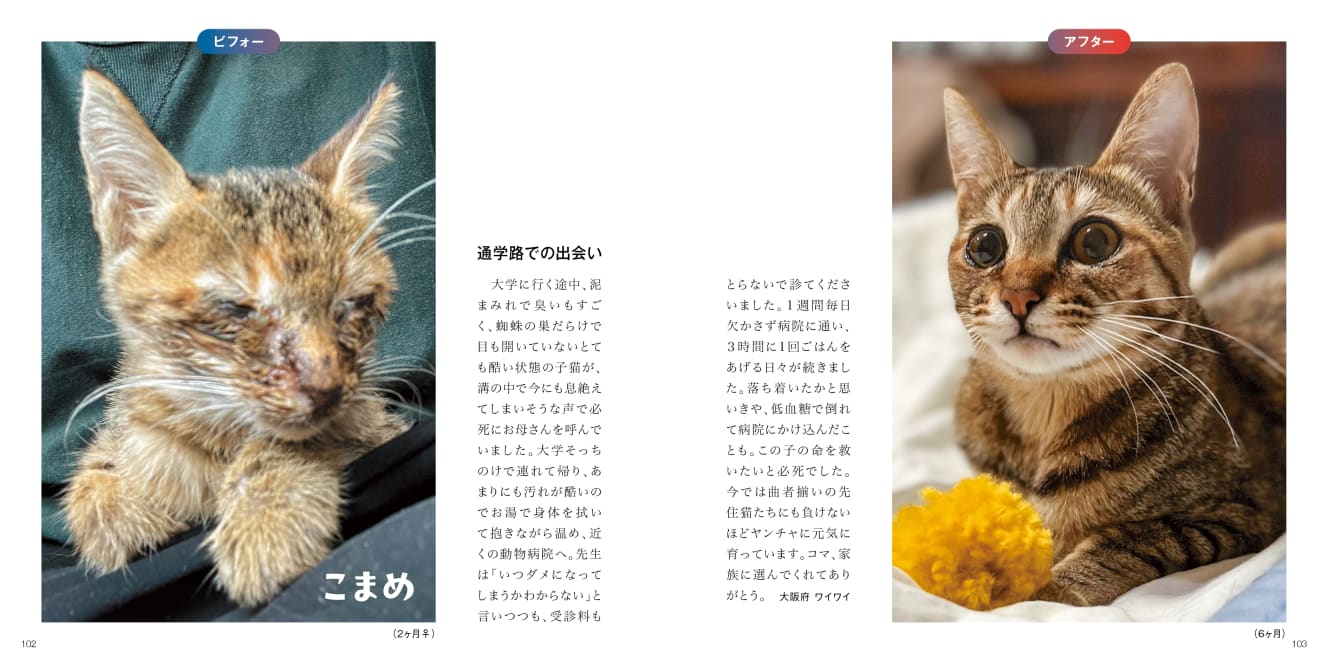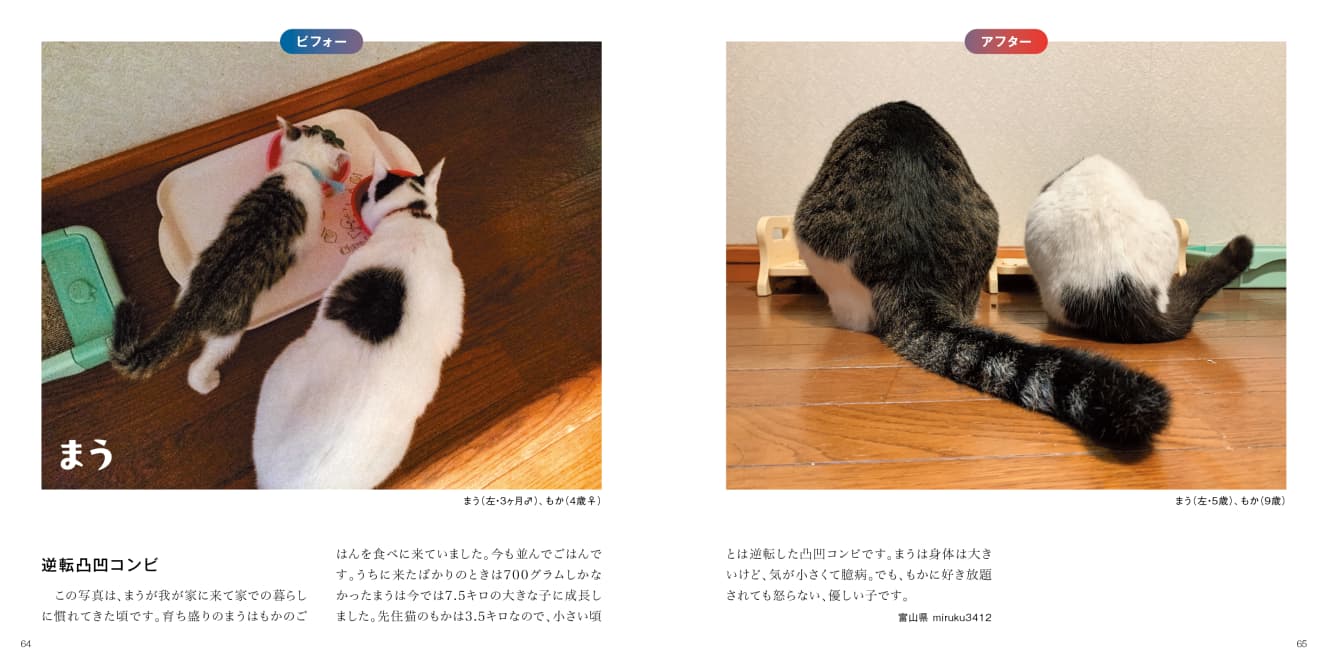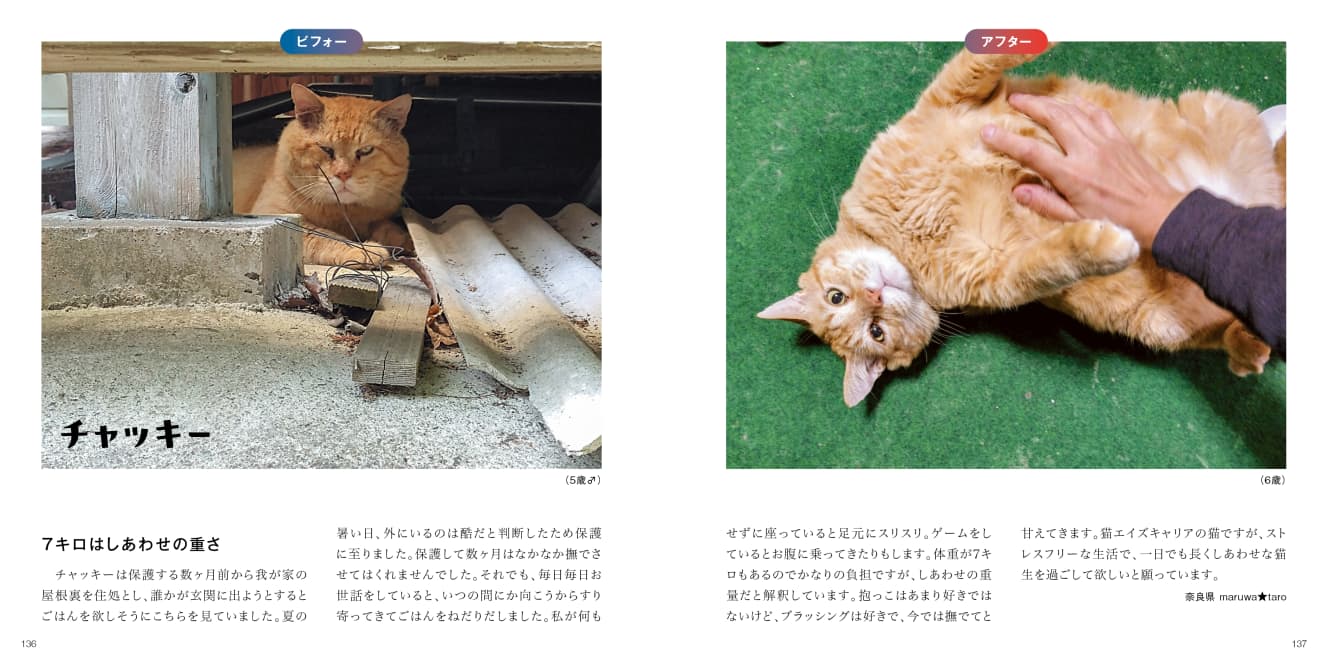The “before and after” story of a shelter cat and its owner, told in two photos.

Cats that at first glance appear to be living freely and carefree outside are actually living in a very harsh environment. In fact, some of the newly-protected cats actually have very stern and severe expressions on their faces. But once they spend time in a home and receive lots of love from their families, their faces change to a very gentle expression within a year or two.
says Ms. Mayuko Miyahara, editor of the cat magazine “Neko Biyori.
How did these shelter cats change after meeting their current owners? The 48 “before and afters” of these cats are included in the book “Minna Happiness! Protection Cats Before and After” (edited by the Neko Biyori editorial department, Tatsumi Shuppan), which contains 48 such “before and after” stories, has been published.
The book is a collection of cats interviewed in the quarterly magazine “Neko Biyori” and the mook book “Nekomaru,” as well as submissions from their owners solicited via SNS. Some of the cats were given to us by shelters, others were picked up by dogs after they were found mewling in the grass, others were rescued from drowning in heavy rain, and so on, all with various dramas before meeting their owners. The transformation of these cats from the “before” to the “after” after spending months with their owners is astonishing.
In recent years, the term “shelter cats” has become quite common, but what kind of cats are “sheltered” and why should they be “protected”? We asked Mr. Miyahara about the basics of “protecting” cats.
Generally speaking, a protected cat is a cat that has been taken care of by a public health center, volunteer workers, or an NPO.
In many cases, stray cats that have not been spayed or neutered, or kittens that have been separated from their mothers shortly after birth, are taken in. There are also cases of cats being taken in by public health centers or other organizations after a cat has been adopted by a group of cats that have been separated from their mothers. It is difficult to define what kind of cat a shelter cat is, but I think the closest we can come is to say that it is not a domesticated cat, but a cat that has been taken in for some reason or another.
According to Mr. Miyahara, there are few cases in Japan today where cats are thought to survive by taking mice and small animals on their own and eating only those animals, and they basically survive by being fed by humans. In other words, cats are beings that should coexist in human society.
However, simply feeding them will only increase the number of cats, which in turn will increase the number of unhappy cats. There are many cases where cats are spayed or neutered by shelter groups or volunteers, and then coexist as “community cats. Recently, however, there is a growing awareness that cats are happier when they are kept inside the house rather than outside.
The outside world is not an easy place for cats to live. There is extreme heat and severe cold, and above all, there is a high risk of traffic accidents when they are outside. There are also terrible people who catch and abuse them.
There is also the risk of cats fighting with other cats and contracting viruses, so basically, I think that cat protection groups and people involved with cats want to keep all cats indoors. I can’t say for sure since I can’t ask the cats themselves, but if they live inside and visit the veterinary clinic regularly, their healthy life expectancy will surely be extended.
So how do you actually adopt a shelter cat? The book touches in part on what to do when you find a cat and how to protect it, but we asked him to tell us the general method.
When you want to adopt a shelter cat, I think the easiest way to do so is to look up the cat on a foster care website. If there is a cat you are interested in on the website, you can contact the owner.
At the transferring meeting, you can actually see the cat, so it is easy to understand what kind of cat it is, and you can also ask the organization about precautions in actually keeping a shelter cat.
However, depending on the organization, there are often strict conditions for transferring a cat. Some organizations check the environment in which the cats are kept, and some refuse to accept them if they live alone. Some of the cats that have been rescued have lived in harsh environments, and some of them have been subjected to horrific experiences by humans. Therefore, people at organizations that give cats away want to make sure that the cats are happy without any accidents. Therefore, owners must be prepared to take care of their cats, rather than just taking them in casually.
Among the shelter cats that Miyahara interviewed, the one that left a particularly strong impression on him was “Shobobo,” a large brown-and-white male cat.
Shobobo is the cat of a person who has nearly 20,000 followers on X, and he was famous for being in the news. I was originally a fan of Shobobo’s, and when I approached him about doing an interview for Nekomaru, he said, ‘Even if you came to my house to interview Shobobo, I think he would definitely hide because he doesn’t like people other than his family.
When Shobobo first came to the owner’s house, he was always hiding in the shadows. But now he has become a dignified and imposing cat, and he is very cute. His body is so big and he stands so tall that I wonder, “What kind of cat is this⁉”. And his face is very unique. I think he is very cute, but he is not the type of cat that everyone would say, “He is so cute! But he is not the type of cat that everyone would say, “He’s so cute!
But the owner loves Shobo very much. As written in the book, “We are filled with joy when we see Shobobo clumsily pampering us as hard as he can. Please keep Shobobo as a big, cute, and somewhat strange cat. I think the owner’s words, “I love Shobobo’s personality more than anyone else in this world,” sums up the feelings of those who love shelter cats. I cry every time I read this interview.”
Unlike pet store cats, which have been in contact with people since shortly after birth and are accustomed to people to some extent, some of the shelter cats that have lived in harsh environments will not let you touch them even if you have kept them for several years. However, it is precisely because they are such cats that they are so happy when they are pampered because they trust them.
Some of the shelter cats have personalities and personalities that their owners never thought they would have, and over the years they gradually reveal them.
Of course, it depends on the cat, but even if it takes many years, I think they will love you back as much as you love them. I think the appeal of shelter cats is that they teach us the joy of loving and being loved. I hope that people who pick up this book will understand that.
From the first encounter to the present. We hope you will take a look at the 48 stories of shelter cats and their owners.






